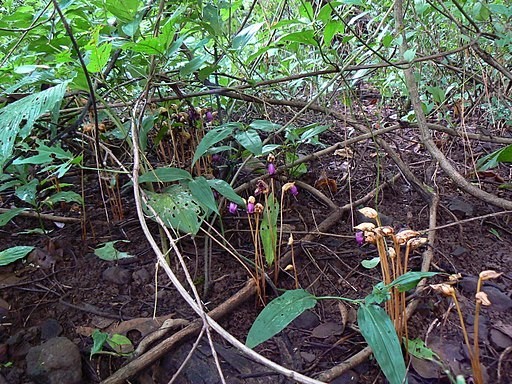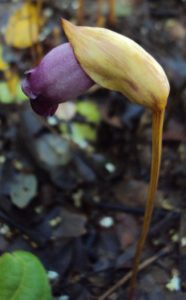Scientific name: Aeginetia indica
English common name: Indian Broomrape, Ghost Flower
Lao name: Sop heng (translates as “bird’s mouth”)
Plant family: Orobanchaceae
Plants make their own food. It’s photosynthesis. Everyone knows that, right? Plants use water and energy from the Sun to turn nutrients from the ground into useful compounds. These can then be used for growth, reproduction and a multitude of survival strategies. It’s miraculous and ingenious, and has been a popular topic in the school curriculum for quite some time. But to say “and that’s that” would be both boring and, more importantly, entirely untrue.
There are certain plants which tend to be kept quiet when distinctions between plants, animals and fungi are being explained, and our plant of the month, Aeginetia indica, is one of them. Generally speaking, plants are ‘autotrophs’; they manufacture their own food for energy. But incredibly, the feeding habits of A. indica are closer to those of animals and fungi, all of which consume their food by either eating or absorbing useful carbon-based compounds – they are known as heterotrophs. Because of this feeding strategy, Indian Broomrape doesn’t need to produce chlorophyll, the substance that makes leaves green and is central to photosynthesis. And why stop there? If the leaves no longer serve any purpose, why bother growing them at all? In truth A. indica does have leaves, but the few it has are reduced to small discreet scales at the base of the flower stem.

You can see the pale stalks of A. indica sticking up out of the ground – not a green leaf in sight! Photo from Wikimedia Commons.
So how has Indian Broomrape managed this devious and cunning switch to the dark side, where it no longer needs light in its quest for food? In effect it exploits the root systems of larger plants. Using an appendage called a haustorium, it penetrates a section of root and fuses to it, drawing from the xylem and phloem which transport water and hard-earned food around the host plant. This makes Indian Broomrape a parasite.
Some plants are opportunistic in their parasitism (‘hemiparasites’), benefiting from a host but often being able to photosynthesise and complete their life-cycles on their own (these are called facultative parasites). In contrast, A. indica is known as a holoparasite (‘holo’= whole, complete). In other words, it relies completely upon a host in order to survive and reproduce.

A close up of an Indian Broomrape flower. Photo from Wikimedia Commons.
In case this feat of botanical treachery was not enough to earn A. indica a place on Plant of the Month, this fascinating plant has a few more points of intrigue. For one thing there is its curious appearance. Needing no light, it can be found in gloomy areas of forest where the white and purple flowers seem almost to emit an eerie glow.
Additionally, as is often the case with plants in Laos, it has a number of local medicinal uses These include making tea to ease a sore throat and heartburn, using the crushed flowers on stings and bites, and treating burns with the small black seeds.
If this leaves you wanting to know more about parasitic plants, more information can be found here.
By Jon Wells, Ecologist and currently volunteering at PTK
Photo credits:
Photograph of Aegenetia indica in the forest by Dinesh Valke from Thane, India (Aankuri Bankuri (Hindi: आँकुरी बाँकुरी)) CC BY-SA 2.0 (https://creativecommons.org/licenses/by-sa/2.0) via Wikimedia Commons.
Close up photograph of Aegenetia indica flower by Vinayaraj (Own work) CC BY-SA 3.0 (https://creativecommons.org/licenses/by-sa/3.0), via Wikimedia Commons.
Glossary
Hemiparasites contain chlorophyll when mature (hence photosynthsis), and largely tap into the host xylem which provides them with water and dissolved nutrients, with which they can synthesise carbon compounds.
Holoparasites tap into xylem and phloem-obtain all of their carbon compounds from the host plant, and produce none themselves-they require their host to complete their lifecycle, and so are obligate parasites. While this theoretical distinction is clear-cut, intermediates do exist.
References
Anurada, A., Kumbhojkar, M. S. And Vartak, V. D. (1986) Observations on wild plants used in folk medicine in the rural areas of the kolhapur district. Ancient Science of Life. 6: 119-121.
Kusano, S. (1903). Notes on Aeginetia indica, Linn. Botanical Magazine.
Nickrent, D. L. and Musselman, L. J. (2004) Introduction to Parasitic Flowering Plants. The Plant Health Instructor.


